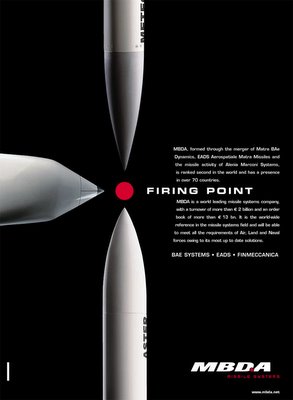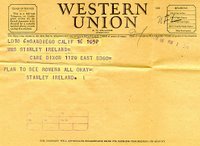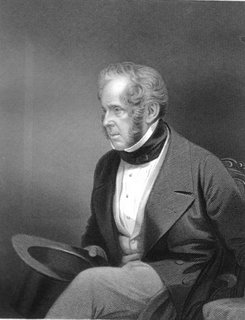 What makes a niche market? Unless you’re in one, you’d hardly believe the amount of advertising done in specialized markets, or the amount of marcom money spent in them. Today’s example: the defense business.
What makes a niche market? Unless you’re in one, you’d hardly believe the amount of advertising done in specialized markets, or the amount of marcom money spent in them. Today’s example: the defense business.You won’t run across weapons systems ads in People, American Girl, or Bon Appétit. You won’t find “Defense Industry” if you go to the 1997 NAICS and 1987 SIC Correspondence Tables, the newer North American Industry Classification System (NAICS) that superseded the old SIC codes. Search for “Military Contractors” or “Weapons Systems.” No NAICS class for any of them.
I bring it up because Charles de la Rochefoucauld kindly sent along some ads for one of his clients, MBDA, that I concepted a while back. They were based on the new corporate logo with its red point that Charles’s team created.
Creating the brand, working with the client, producing the ads, buying the media…all done by La Rochefoucauld, part of Publicis in Paris. (Charles now heads up another Publicis operating unit, Corporate Factory.)
The ad on the right is for weapons systems – missiles, to be precise. It’s dramatically simple and builds a “pointed” impression for the brand, even in magazines filled with war-fighting materiel. The client chose the series represented by this ad to start their post-merger campaign. Today, MBDA is the only company in its sector able to design and produce missile systems for land-based, naval, and airborne missions.
The MBDA ads are the latest examples of work I’ve done for the defense industry over the past few decades: for RPVs (think “Predator” drones, the current equivalent), ballistic fire control computers for the M1 Abrams, electronic warfare systems, air traffic control systems – you name it. Serious toys for big boys…and a significant contributor to ad agencies’ bottom lines for decades.
Bill Mitchell was working for the Wyatt & Williams agency in Dallas when I was with Kerker & Associates in Minneapolis. He worked on the Bell Helicopter account; I was working on ads for Sperry’s Defense Systems unit. I found out recently that he donated a collection of his materials to the Texas/Dallas History & Archives of the Dallas Public Library.
It’s called (naturally) the Mitchell Defense Industry Advertisement Collection: approximately fifty advertisements pertaining to Dallas-based companies involved in the defense industry. The collection’s ads are from as early as 1953, when Mitchell worked for Tracy-Locke Advertising, and as current as the early 1990s, when he moved from Dallas.
Someday, maybe I’ll pull on my defense-industry ad materials together and donate them to some deserving library. Meanwhile, I’ll keep working on new defense ads – way too much fun.










 Hubcap ads may have started in Singapore. They may have started in the
Hubcap ads may have started in Singapore. They may have started in the 


